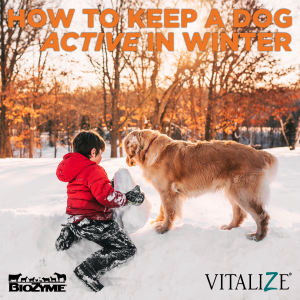
“Oh, my aching hip!” You might proclaim this after a night out dancing with friends or after a long run. Or, if you are approaching mid-life and perch in front of a computer all day, you could also have similar hip and joint issues. However, we never wish hip and joint pain on our four-legged dog friends who can’t tell us when they hurt.
Unfortunately, hip dysplasia in dogs is a common skeletal condition. It impacts many large and giant breed dogs. It can also occur in smaller breeds, too. The Vitalize® team is filled with dog lovers, and we want to be sure you know how to prevent hip dysplasia in dogs.
Choose the Right Breed
Everyone has a favorite breed. We all have breed preferences, too. Some people like small breeds, some large. Some prefer really furry dogs, while others prefer the short-hair breeds.
However, if you research your ideal breeds, you will find that some are more prone to hip dysplasia in dogs. These breeds include German Shepherds, Labrador Retrievers, Golden Retrievers and Bulldogs.
If you’re considering one of these breeds, ask the breeder about the health history of the parents, including hip evaluations. A reputable breeder should be willing to share all health information about its breeding program with you.
Responsible breeders often screen for hip dysplasia in dogs with genetic testing. If you have a choice, when selecting your next pet, choose a breeder who prioritizes genetic health, especially with a breed that is predisposed to hip dysplasia.
But, let’s say you have a dog susceptible to hip dysplasia. What do you do then? How can you prevent it, or minimize your pet’s risk level?
How To Prevent Hip Dysplasia in Dogs
Maintain a Healthy Weight
Obesity puts extra stress on a dog’s joints, increasing the likelihood of hip dysplasia or worsening its symptoms. Feed your dog a balanced diet, avoid as much human food as possible and avoid overfeeding.
If you are unsure how much is the proper amount of food for your fur baby, consult with your veterinarian to establish a feeding plan. A proper feeding plan includes the correct portion sizes based on the dog’s breed, age and activity level.
Provide Suitable Exercise
Exercise for your dog is important, but not all exercise is good for your dog. Consider the following activities to help build muscle without putting extra strain on the hips:
- Swimming
- Walking
- Controlled running
Avoid these activities, especially in younger dogs and puppies:
- Jumping
- Sudden turns
- Hard landings
When it comes to puppies, avoid over-exercising, especially large breeds, as their joints are still developing.
Avoid Overexertion in Puppies
During the rapid growth stages, up to 18 months for large breeds, puppies are especially vulnerable to joint issues.
During these early months, avoid high-impact activities like long runs or jumps. There is a reason puppies sleep so much, and that is because when they are sleeping, they are growing.
Provide Proper Nutrition
Feed your dog a well-balanced, high-quality diet. A dog nutrition plan should include protein, carbohydrates, vitamins, minerals, fats, fiber, animo acids and water. Nutrients like omega-3 fatty acids, glucosamine, chondroitin and hyaluronic acid can help support joint health.
For puppies, especially large breeds, choose a diet specifically formulated for their growth to avoid excessive rapid growth, which can contribute to hip dysplasia.
Vitalize® Trixsyn® Canine is a liquid product for dogs designed to support joint health using hyaluronic acid, MHB3®, a patented, high molecular weight hyaluronic acid. Vitalize Trixsyn Canine supports hip and joint health and mobility. Adding Vitalize Trixsyn Canine to the diet is a great way to help support hip and joint health and one way how to prevent hip dysplasia in dogs.
Build a Relationship with your Vet
At Vitalize, we are big believers in building a relationship with your veterinarian. It helps your vet know what your canine companion looks and acts like when it is healthy. And for your peace of mind, it helps reduce the likelihood dog anxiety when you do go to the doggie doc for an emergency.
Even better, routine veterinary visits can help catch signs of hip dysplasia in dogs early. Your vet can perform physical exams, and if needed, take X-rays to assess joint health.
If you detect signs of hip dysplasia, your vet may recommend joint supplements, physical therapy or medication to slow the progression of the condition.
By following these steps or a combination of them, you can help prevent hip dysplasia or manage its impact if your dog is predisposed to the condition.
Why Vitalize?
Vitalize is a line of supplements for horses, dogs and cats with proven solutions to keep your animal healthy and performing. Although we mentioned Vitalize Trixysin Canine, we also offer Vitalize Trixsyn Canine Performance. Both are powered by MHB3 Hyaluronan.
MHB3 Hyaluranon
MHB3 Hyaluronan is a natural hyaluronic acid (HA) bioidentical to the HA naturally produced by the body. That means there is minimal risk of complication or malabsorption.
MHB3 is unique to other hyaluronic acid ingredients on the market due to its oral liquid formulation that allows for quick absorption and maximum. Liquid supplementation with MHB3 is research-proven to be 3.8 times more effective than dry forms of hyaluronic acid.
MHB3 currently holds 8 U.S. patents for its role in improving bone and joint health including. Some of those include:
- For the prevention and maintenance of osteoarthritis
- For the prevention and maintenance of osteopenia – the precursor to osteoporosis
- For the prevention of osteophytes or bone spurs
- More generally, it has a role in improving joint health.
How MHB3 Helps
MHB3 improves the symptoms of osteoarthritis as well as symptom frequency.
A 30-day course of MHB3 treatment reduces friction within the joint and preserves protective cartilage preventing the formation of bone spurs. This results in more fluid movement, less pain and increased range of motion.
Treatment with MHB3 decreases markers of bone breakdown, having a positive impact on bone mineral density and bone formation.
Study-backed outcomes associated with MHB3:
- Tissue hydration
- Anti-inflammation
- Cartilage protection
- Osteophyte prevention
- Pain reduction
- Increased range of motion
Both Trixsyn Canine products are simple to use, require no prescriptions and don’t require the labor or mess of a shot or topical ointment. They come in an easy-to-use, pump bottle. Dosage is determined by dog size and weight, and each dog gets 1 to 3 pumps on their food twice daily, depending on size.
Get your Vitalize Today!
If you are looking to prevent hip dysplasia in dogs you care for, we hope this blog has helped give you some tools for preventative care! While we genuinely believe incorporating Vitalize into their diet will help your pup, our real goal is to provide resources to help you care for your family.
So, support your pet’s joint health with Vitalize Trixsyn. Get your Vitalize today. We have made purchasing Vitalize as easy as possible. You can visit your local dealer to purchase Vitalize products. Locate a dealer near you, today.
Perhaps you prefer the convenience of online shopping. You can shop online and have Vitalize delivered right to your front door.
Sign Up for Our Newsletter
Want to learn more about other ways to take care of your furry friends? Visit the Vitalize blog today and sign up for our electronic newsletter.

